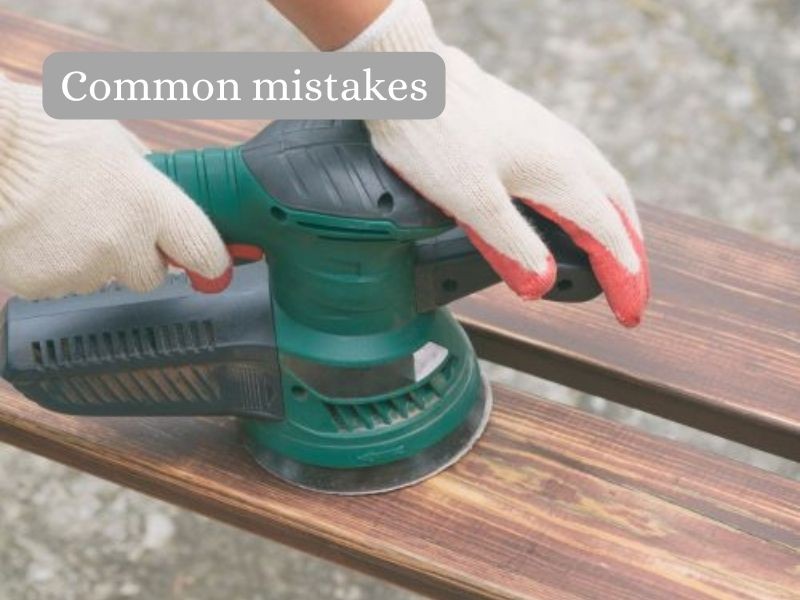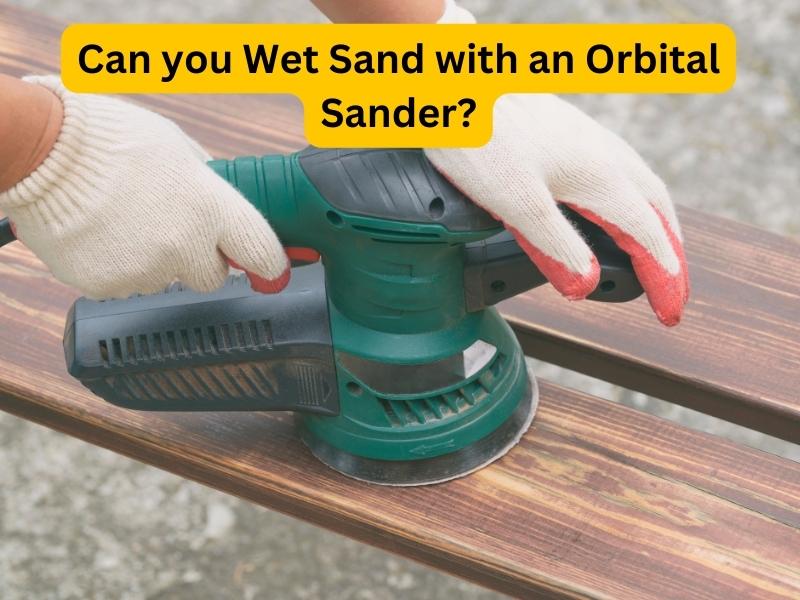When it comes to sanding, there are two methods that can be used:
- Dry Sanding
- Wet Sanding
In this blog post, we will focus on how to wet sand with an orbital sander. This is a great method for removing scratches and other blemishes from wood surfaces. It can also help achieve a smooth finish.
Can you Wet Sand with an Orbital Sander?
Yes, you can wet sand with an orbital sander. Wet sanding is a better option when you are trying to remove paint or varnish from a surface. An orbital sander is more likely to damage the surface you are trying to sand if you are not careful. If you are going to wet sand, make sure you’re using the right kind of paper for your sander. When wet sanding, always use a light touch and be careful not to damage the surface you’re trying to sand.
How can you Wet Sand with an Orbital Sander?

Wet sanding with an orbital sander is a great way to get a smooth, even finish. Here’s a step-by-step guide on how to wet sand with an orbital sander:
- The first thing you’ll need to do is gather your materials. You will need a bucket of water, sandpaper, and your orbital sander.
- Make sure the sandpaper is wet/damp before beginning.
- Begin by sanding with light pressure, gradually increasing as needed.
- Remember to keep the sander moving to avoid damaging the surface.
- Sand in a circular motion and keep the sander level to avoid gouging the surface.
- Check your progress often and change the sandpaper when it becomes clogged or ineffective.
- When you are finished, remove any remaining water and dry the area completely.
By following these simple steps, you can achieve professional results at home. Give it a try next time you have a sanding project.
Things to keep in mind while Wet Sanding with an Orbital Sander:
Wet sanding with an orbital sander can be a great way to achieve a smooth, consistent finish on your project. However, there are a few things you should keep in mind while wet sanding.
- Always use a properly rated dust mask to protect yourself from the fine dust particles created by sanding.
- Make sure you keep the sander moving across the surface to avoid creating deep scratches.
- To avoid damaging the surface, always sand with the grain of the wood.
Common mistakes while Wet Sanding with an Orbital Sander:

Here are some common mistakes that people make while wet sanding with an orbital sander:
1. Not Sanding in a Well-Ventilated Area:
When sanding, it’s important to do so in a well-ventilated area. The dust created from sanding can be harmful to your lungs, so it’s important to be in an area where the dust can dissipate quickly.
2. Not Wearing a Dust Mask:
In addition to sanding in a well-ventilated area, it’s also important to wear a dust mask. This will help to protect your lungs from the harmful dust created while sanding.
3. Sanding Too aggressively:
One mistake that people often make while wet sanding is sanding too aggressively. This can damage the surface you’re sanding, and it can also cause the orbital sander to gouge the surface. It’s important to sand gently and evenly to avoid these problems.
4. Not keeping the sander moving:
When you are wet sanding, it is important to keep the sander moving at all times. If you stop in one spot for too long, you run the risk of damaging the paint or leaving swirl marks.
5. Not using enough pressure:
Another common mistake is not using enough pressure. You need to apply enough pressure to level the paint, but not too much pressure that you damage the paint.
6. Not using the right grit sandpaper:
The type of grit sandpaper you use will depend on the type of paint and how many coats there are. You don’t want to use a grit that is too high or you could damage the paint.
7. Applying too much pressure:
This is probably the most common mistake people make when wet sanding. You need to apply enough pressure to level the paint, but not too much pressure that you damage the paint.
If you follow these tips, you should be able to wet sand your vehicle with no problems.
Pros of Wet Sanding with an Orbital Sander:
- Wet sanding with an orbital sander is much faster than hand sanding.
- It is easier to control the orbital sander than it is to control your hand.
- The orbital sander will not leave behind any swirl marks as your hand might.
- Wet sanding with an orbital sander will create a much smoother surface than hand sanding.
Cons of Wet Sanding with an Orbital Sander:
- If you’re not careful, it’s easy to gouge or damage the surface you’re sanding.
- Orbital sanders are also more expensive than traditional hand sanders.
FAQS:
Q: How long does wet sanding take?
A: Wet sanding is a time-consuming process. Depending on the size of the area you’re working on, it could take several hours to complete.
Q: What kind of paper should I use for wet sanding?
A: There are a few different types of paper that can be used for wet sanding, but the most common is probably sandpaper. Wet sanding with sandpaper will give you a smoother finish than dry sanding, and it’s also less likely to damage the paint on your car.
Q: Is wet sanding bad for my health?
A: The short answer is yes, wet sanding can be bad for your health if you don’t take the proper precautions. Wet sanding can lead to a number of health problems, including respiratory problems, skin irritation, and even cancer.
Q: What is wet sanding?
A: Wet sanding is the process of using sandpaper on wet surfaces. This method is often used to remove paint, varnish, or other finishes from wood or metal surfaces. Wet sanding is also used to smooth out rough surfaces and prepare them for painting or staining.
Q: Advantage of wet sanding over dry sanding?
A: Here are a few advantages of wet sanding over dry sanding:
- The main advantage of wet sanding over dry sanding is that it significantly reduces the amount of dust created.
- Dry sanding can create a large amount of dust that can be difficult to clean up, while wet sanding eliminates most of the dust.
- In addition, wet sanding produces a smoother finish and can be less abrasive on the surface being sanded.
- Wet sanding is often the preferred method for preparing a surface for painting or staining.
Q: What is the difference between wet sanding and dry sanding?
A: Wet sanding is a process of using water with sandpaper to remove old finishes or paint, while dry sanding is the process of using only sandpaper to remove these things. While both have their benefits, wet sanding is generally the better option as it prevents dust from getting into the air and onto surfaces. It also helps to keep the sandpaper from clogging up as quickly. Dry sanding can be more effective at removing heavy finishes or paint, but it also creates a lot of dust that can be difficult to clean up and can be harmful to breathe in. When sanding any surface, always be sure to wear a mask and eye protection to avoid inhaling dust or getting it in your eyes.
